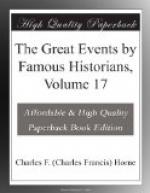Among the European scientists and inventors to whom both Henry and Morse were indebted was the French electrician, Andre Marie Ampere (1775-1836), whose name (ampere) has been given to the practical unit of electric-current strength. Ampere was the first and is the most famous investigator in electrodynamics. He also invented a telegraphic arrangement in which he used the magnetic needle and coil and the galvanic battery. Others, in the latter part of the eighteenth century and the earlier years of the nineteenth, devised similar arrangements. But no strictly electromagnetic apparatus for telegraphic signalling was put to successful use until 1836, when, in England, Charles Wheatstone, who is commonly regarded as the first inventor of practical electric telegraphy, constructed an apparatus whereby thirty signals were transmitted through nearly four miles of wire. From 1837 to 1843 he had as an associate William Fothergill Cooke, and the two worked together to develop the electric telegraph. They afterward quarrelled over their respective claims to credit, but in 1838-1841 telegraph lines secured by their patents were set up on the Great Western and two other English railways.
Meanwhile other inventors were still working for the same results, in many parts of the world, and it has been significantly said that “the electric telegraph had, properly speaking, no inventor; it grew up little by little.” Nevertheless with respect to the distinctive character of Morse’s improvements, and his title to a peculiar place among those through whose labors the electric telegraph “grew,” there can be no question.
Alonzo B. Cornell, son of the founder of Cornell University, at one time Governor of New York, was intimately connected with electrical and telegraphic affairs for many years; therefore on the subject here presented he speaks with professional authority. His father was the first builder of the Morse telegraphs.
* * * * *
During the early years of the nineteenth century but slight advance was made in the development of electrical science, although there were many persons both here and abroad engaged in experimental work, and there was considerable increase of literature bearing upon the subject. It was reserved for another illustrious American to accomplish the next important and decisive step in the pathway of progress. In 1828 Joseph Henry, then professor of physics at the Albany Academy, afterward a professor at Princeton, and subsequently for many years secretary of the Smithsonian Institution at Washington, made the highly important discovery that by winding a plain iron core with many layers of insulated wire, through which the electric current was passed, he could at pleasure charge and discharge the iron core with magnetic power. Thus Henry produced the electromagnet which was the beginning of the mastery by man of the subtle fluid. He also discovered that the intensity and power of the electric current were materially augmented by increasing the number of the series of battery plates without increasing the quantity of metal used in their construction.




